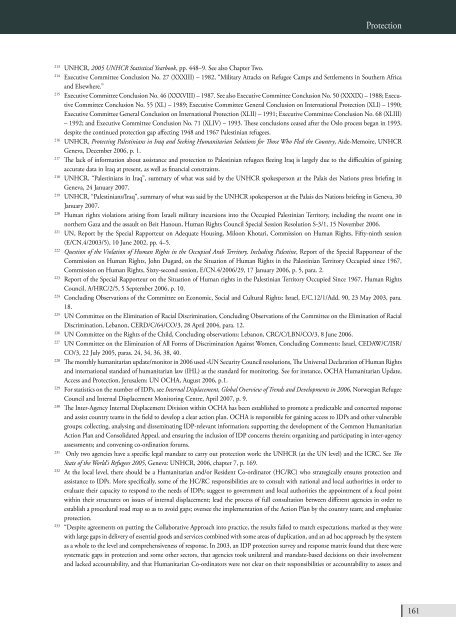BADIL Resource Center for Palestinian Residency and Refugee
BADIL Resource Center for Palestinian Residency and Refugee
BADIL Resource Center for Palestinian Residency and Refugee
You also want an ePaper? Increase the reach of your titles
YUMPU automatically turns print PDFs into web optimized ePapers that Google loves.
Protection<br />
213 UNHCR, 2005 UNHCR Statistical Yearbook, pp. 448–9. See also Chapter Two.<br />
214 Executive Committee Conclusion No. 27 (XXXIII) – 1982, “Military Attacks on <strong>Refugee</strong> Camps <strong>and</strong> Settlements in Southern Africa<br />
<strong>and</strong> Elsewhere.”<br />
215 Executive Committee Conclusion No. 46 (XXXVIII) – 1987. See also Executive Committee Conclusion No. 50 (XXXIX) – 1988; Executive<br />
Committee Conclusion No. 55 (XL) – 1989; Executive Committee General Conclusion on International Protection (XLI) – 1990;<br />
Executive Committee General Conclusion on International Protection (XLII) – 1991; Executive Committee Conclusion No. 68 (XLIII)<br />
– 1992; <strong>and</strong> Executive Committee Conclusion No. 71 (XLIV) – 1993. These conclusions ceased after the Oslo process began in 1993,<br />
despite the continued protection gap affecting 1948 <strong>and</strong> 1967 <strong>Palestinian</strong> refugees.<br />
216 UNHCR, Protecting <strong>Palestinian</strong>s in Iraq <strong>and</strong> Seeking Humanitarian Solutions <strong>for</strong> Those Who Fled the Country, Aide-Memoire, UNHCR<br />
Geneva, December 2006, p. 1.<br />
217 The lack of in<strong>for</strong>mation about assistance <strong>and</strong> protection to <strong>Palestinian</strong> refugees fleeing Iraq is largely due to the difficulties of gaining<br />
accurate data in Iraq at present, as well as financial constraints.<br />
218 UNHCR, “<strong>Palestinian</strong>s in Iraq”, summary of what was said by the UNHCR spokesperson at the Palais des Nations press briefing in<br />
Geneva, 24 January 2007.<br />
219 UNHCR, “<strong>Palestinian</strong>s/Iraq”, summary of what was said by the UNHCR spokesperson at the Palais des Nations briefing in Geneva, 30<br />
January 2007.<br />
220 Human rights violations arising from Israeli military incursions into the Occupied <strong>Palestinian</strong> Territory, including the recent one in<br />
northern Gaza <strong>and</strong> the assault on Beit Hanoun, Human Rights Council Special Session Resolution S-3/1, 15 November 2006.<br />
221 UN, Report by the Special Rapporteur on Adequate Housing, Miloon Khotari, Commission on Human Rights, Fifty-ninth session<br />
(E/CN.4/2003/5), 10 June 2002, pp. 4–5.<br />
222 Question of the Violation of Human Rights in the Occupied Arab Territory, Including Palestine, Report of the Special Rapporteur of the<br />
Commission on Human Rights, John Dugard, on the Situation of Human Rights in the <strong>Palestinian</strong> Territory Occupied since 1967,<br />
Commission on Human Rights, Sixty-second session, E/CN.4/2006/29, 17 January 2006, p. 5, para. 2.<br />
223 Report of the Special Rapporteur on the Situation of Human rights in the <strong>Palestinian</strong> Territory Occupied Since 1967, Human Rights<br />
Council, A/HRC/2/5, 5 September 2006, p. 10.<br />
224 Concluding Observations of the Committee on Economic, Social <strong>and</strong> Cultural Rights: Israel, E/C.12/1/Add. 90, 23 May 2003, para.<br />
18.<br />
225 UN Committee on the Elimination of Racial Discrimination, Concluding Observations of the Committee on the Elimination of Racial<br />
Discrimination, Lebanon, CERD/C/64/CO/3, 28 April 2004, para. 12.<br />
226 UN Committee on the Rights of the Child, Concluding observations: Lebanon, CRC/C/LBN/CO/3, 8 June 2006.<br />
227 UN Committee on the Elimination of All Forms of Discrimination Against Women, Concluding Comments: Israel, CEDAW/C/ISR/<br />
CO/3, 22 July 2005, paras. 24, 34, 36, 38, 40.<br />
228 The monthly humanitarian update/monitor in 2006 used «UN Security Council resolutions, The Universal Declaration of Human Rights<br />
<strong>and</strong> international st<strong>and</strong>ard of humanitarian law (IHL) as the st<strong>and</strong>ard <strong>for</strong> monitoring. See <strong>for</strong> instance, OCHA Humanitarian Update,<br />
Access <strong>and</strong> Protection, Jerusalem: UN OCHA, August 2006, p.1.<br />
229 For statistics on the number of IDPs, see Internal Displacement, Global Overview of Trends <strong>and</strong> Developments in 2006, Norwegian <strong>Refugee</strong><br />
Council <strong>and</strong> Internal Displacement Monitoring Centre, April 2007, p. 9.<br />
230 The Inter-Agency Internal Displacement Division within OCHA has been established to promote a predictable <strong>and</strong> concerted response<br />
<strong>and</strong> assist country teams in the field to develop a clear action plan. OCHA is responsible <strong>for</strong> gaining access to IDPs <strong>and</strong> other vulnerable<br />
groups; collecting, analysing <strong>and</strong> disseminating IDP-relevant in<strong>for</strong>mation; supporting the development of the Common Humanitarian<br />
Action Plan <strong>and</strong> Consolidated Appeal, <strong>and</strong> ensuring the inclusion of IDP concerns therein; organizing <strong>and</strong> participating in inter-agency<br />
assessments; <strong>and</strong> convening co-ordination <strong>for</strong>ums.<br />
231 Only two agencies have a specific legal m<strong>and</strong>ate to carry out protection work: the UNHCR (at the UN level) <strong>and</strong> the ICRC. See The<br />
State of the World’s <strong>Refugee</strong>s 2005, Geneva: UNHCR, 2006, chapter 7, p. 169.<br />
232 At the local level, there should be a Humanitarian <strong>and</strong>/or Resident Co-ordinator (HC/RC) who strategically ensures protection <strong>and</strong><br />
assistance to IDPs. More specifically, some of the HC/RC responsibilities are to consult with national <strong>and</strong> local authorities in order to<br />
evaluate their capacity to respond to the needs of IDPs; suggest to government <strong>and</strong> local authorities the appointment of a focal point<br />
within their structures on issues of internal displacement; lead the process of full consultation between different agencies in order to<br />
establish a procedural road map so as to avoid gaps; oversee the implementation of the Action Plan by the country team; <strong>and</strong> emphasize<br />
protection.<br />
233 “Despite agreements on putting the Collaborative Approach into practice, the results failed to match expectations, marked as they were<br />
with large gaps in delivery of essential goods <strong>and</strong> services combined with some areas of duplication, <strong>and</strong> an ad hoc approach by the system<br />
as a whole to the level <strong>and</strong> comprehensiveness of response. In 2003, an IDP protection survey <strong>and</strong> response matrix found that there were<br />
systematic gaps in protection <strong>and</strong> some other sectors, that agencies took unilateral <strong>and</strong> m<strong>and</strong>ate-based decisions on their involvement<br />
<strong>and</strong> lacked accountability, <strong>and</strong> that Humanitarian Co-ordinators were not clear on their responsibilities or accountability to assess <strong>and</strong><br />
161

















